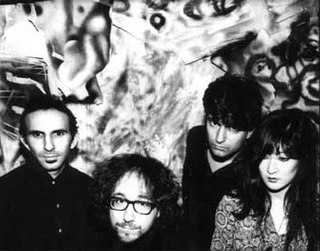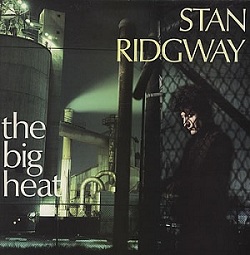Nervous Gender is an American punk rock electronic band formed in Los Angeles in 1978 by Gerardo Velazquez, Edward Stapleton, Phranc and Michael Ochoa.

The Fibonaccis were an American art rock band formed in 1981 in Los Angeles. The band consisted of songwriters John Dentino (keyboards) and Ron Stringer (guitar), Magie Song (vocals), Joe Berardi (drums) and later Tom Corey (bass).

Stanard "Stan" Ridgway is an American singer-songwriter, and film and television composer known for his distinctive voice, dramatic lyrical narratives, and eclectic solo albums. He was the original lead singer and a founding member of the band Wall of Voodoo.
Marc Moreland was an American rock musician. He was the former guitarist for rock band Wall of Voodoo, punk band The Skulls, and rock bands Pretty and Twisted and Department of Crooks. He also released a solo album under the name Marc Moreland Mess.

"Mexican Radio" is a song by American rock band Wall of Voodoo. The track was initially released on their second studio album Call of the West (1982).
Andy Prieboy is an American musician, songwriter, and author. He was lead singer of the band Wall of Voodoo from 1983 to 1988. Later, he produced solo albums, musicals, and a novel.

Call of the West is the second studio album by Los Angeles rock band Wall of Voodoo, released in September 1982. The album contains "Mexican Radio", the group's most well-known song, which was released as a single and whose video received moderate airplay on MTV.

Seven Days in Sammystown is the third studio album by American rock band Wall of Voodoo, released in 1985. This was the first Wall of Voodoo album to include Andy Prieboy on vocals and Ned Leukhardt on drums—following the departure of frontman Stan Ridgway and percussionist Joe Nanini—and also features the return of original bassist Bruce Moreland. It includes their cover version of Merle Travis' "Dark as a Dungeon". The track "Far Side of Crazy" is featured in the 1985 movie Head Office. The album reached No. 50 on the Australian charts.

Stereo is a studio album by the American band Vallejo, released in 2002.

Happy Planet is the fourth and final studio album by American rock band Wall of Voodoo, released in 1987. It marked the return of producer Richard Mazda, who had produced their 1982 album Call of the West.

The Index Masters is a compilation album by American rock band Wall of Voodoo, featuring their original 1980 EP and live recordings from 1979. Originally released in 1991 by Restless Records, it was reissued in 2005 by Rykodisc.

Dark Continent is the debut studio album by the American rock band Wall of Voodoo, released in 1981 by I.R.S. Records. Early live versions of four songs are featured on the compilation The Index Masters.

The Big Heat is the debut solo album by American musician Stan Ridgway, released in 1986 by I.R.S. Records. Named after the 1953 film noir of the same name, the original release consisted of nine songs, including the No. 4 UK hit "Camouflage". In 1986, the album reached No. 131 on the Billboard 200. The album was re-released in 1993 with six additional tracks and again re-released in 2007.
"Far Side of Crazy" is a song by the American rock band Wall of Voodoo from their album Seven Days in Sammystown. It was released as the album's lead single in late 1985, with an accompanying music video combining black and white and full color footage. The song was also featured in the 1985 movie Head Office.

The Ugly Americans in Australia is a live album by American rock band Wall of Voodoo, mostly recorded at the Palace Theatre in Melbourne in August 1987, during the group's Australian tour.
Oliver Joseph Nanini was an American rock drummer, most famous for being the percussionist and a founding member of new wave group Wall of Voodoo during their heyday in the 1980s. He was known for playing with pots, pans, and other objects. This arrangement can be seen in the motion picture Urgh! A Music War in which Wall Of Voodoo performed a live version of the song "Back In Flesh" from the Dark Continent album, and also later in the video for the hit single "Mexican Radio". Along with Stan Ridgway and Bill Noland, he left the band after their performance at the US Festival in 1983. Nanini went on to become one of the co-founders of the neo-traditional band The Lonesome Strangers and played on their first record, Lonesome Pine.

Mosquitos is the second solo album by Stan Ridgway. It was released in 1989 on Geffen Records.

Partyball is the third album by Stan Ridgway, released in 1991.
William D. Noland is an American musician, composer, and producer best known for his membership in the rock bands Wall of Voodoo and Human Hands during the late 1970s and '80s.
Bruce "Ravens" Moreland is an American rock musician and songwriter. He has worked with such bands as Wall of Voodoo, The Weirdos, Nervous Gender, and Concrete Blonde among others. As of 2011, his current project is known as Ravens Moreland.















